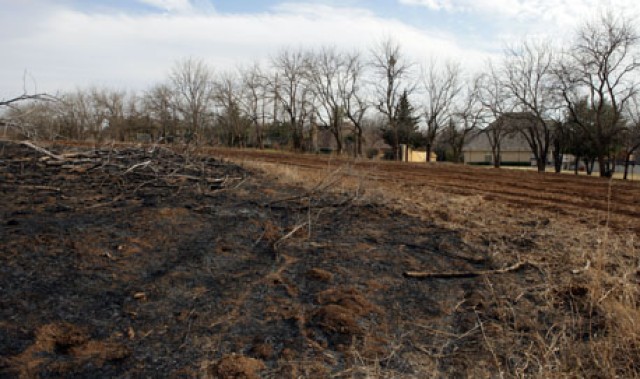When a fire started during training at the Kerr Hill machine gun range here Jan. 20, Soldiers at the range, Range Control officials and firefighters from Fort Sill Fire and Emergency Services responded immediately.
The flames and smoke created a dramatic landscape, because firefighters used a backburn technique to literally fight fire with fire. After almost two hours the fires were extingushed.
The emergency response and results were typical and part of the installation's policy to control any fires that start from live fire exercises.
Fires on Fort Sill's 86,000 acres of training ranges are inevitable because of the volume and types of ordnance expended and Oklahoma's dry seasons and high winds, said Buddy Leavell, range operations officer at the Directorate of Plans, Training, Mobilization and Security's Range Control.
The fires pose minimal danger to the Fort Sill, Lawton and surrounding communities because of range safety; an emergency response system in effect 24/7 with numerous personnel, equipment and agencies; and a firebreak system, said Range Control and firefighting officials.
Every live fire training has an officer in charge and a range safety officer present, who have completed the Range Control safety orientation specific to the range they are using, Leavell said.
This annual training requirement covers many safety issues including what to do in case of a fire.
If a fire starts, the OIC or RSO will radio officials at the Range Control radio room, which is staffed 24 hours, Leavell said. They in turn will call 9-1-1, who will dispatch firefighters from one of the four Fort Sill Fire stations.
Soldiers at the range provide the first line of defense fighting fires because it may be 30 minutes before firefighters can get to the furthest ranges, said Rick Gilleland Fort Sill fire chief.
Depending on the size of fire, Soldiers might fight it using fire flappers - mop handles with broad rubber flaps attached to the end. Soldiers slap at the fire, snuffing it out. Flappers are very effective on short grass but not tall grass, he said.
"Soldiers (with flappers) actually prevented the fire from getting to any of the facilities at Kerr Hill. They were very instrumental," Gilleland said.
There are five impact areas where artillery lands, which are frequently the site of fires. Fires in the impact area are allowed to burn and are monitored. In some cases they have burned for days, said Fort Sill Assistant Fire Chief Ronald Pyle.
The impact areas are too dangerous for personnel and equipment to go in to because of unexploded ordnance, sharp objects and craters.
The impact areas are surrounded by internal firebreaks, 40-foot wide swaths of plowed earth to keep it free of vegetation, said Randy Brous, Quality Assurance evaluator at the Directorate of Public Works. Beyond the impact zone there are buffer zones of varying widths, and whose perimeters are lined by 60-foot wide firebreaks. Workers from the DPW plow the firebreaks twice a year.
The post's firefighters are trained to fight wild range fires and one of the tactics they use is the backburn, Gilleland said.
If wind is fanning a burning area, firefighters will get ahead of the fire and start a backburn at the edge of the firebreak. The backburn is a slow, controlled burn against the wind. When the backburn meets the [JUMP]oncoming fire, the flames go out because there is no more vegetation to burn, Gilleland said.
Prevention
If they see a firebreak that needs to be plowed, they will notify DPW. If there is a heavy growth of vegetation near a firing area, firefighters may do a prescribed burn to eliminate the brush, Gilleland said.
Every morning Fort Sill fire officials provide Range Control with a range status for firing pyrotechnics. Pyrotechnics include smoke grenades, hand grenades, trip flares and tracers, Leavell said. The range status factors in wind, humidity, atmospheric conditions, droughts, etc.
In green status there are no restrictions on pyrotechnics. In amber, only pyrotechnics can be fired within the impact area. No pyrotechnics can be used in red status. In a black status, the commanding general has halted all firing on the installation, according to Fort Sill Regulation 385-1. Most of the time, the ranges are under green or amber status, Pyle said.
The dry Oklahoma winter makes this a time for frequent fires, Leavell said. Summer is another peak time for fires because of the dry conditions, as well as more training because of the influx of Reserve and National Guard Soldiers.
Gilleland emphasized that the responses to range fires are a team effort that involves numerous directorates, the Fort Sill Installation Operations Center, the U.S. Fish and Wildlife Service here and city and county agencies.
The fort has a mutual aid agreement with Lawton, which allows the city's fire crews to assist the fort with incidences and vice-versa, Gilleland said. This applies not only to fires, but events such as hazardous materials spills.
The IOC is informed of everything that the Fort Sill firefighters are doing, Gilleland said. The IOC, in turn, keeps the post commanders informed of fires.
"They (command staff) are very interested. They may get up at 2 o'clock in the morning and do a status check of a fire," Gilleland said.
Pyle said that it is the firefighters' job to keep Fort Sill and its surrounding communities safe.
"We try to make it safe and we sure are going to do our best to make it safe," he said.


Social Sharing